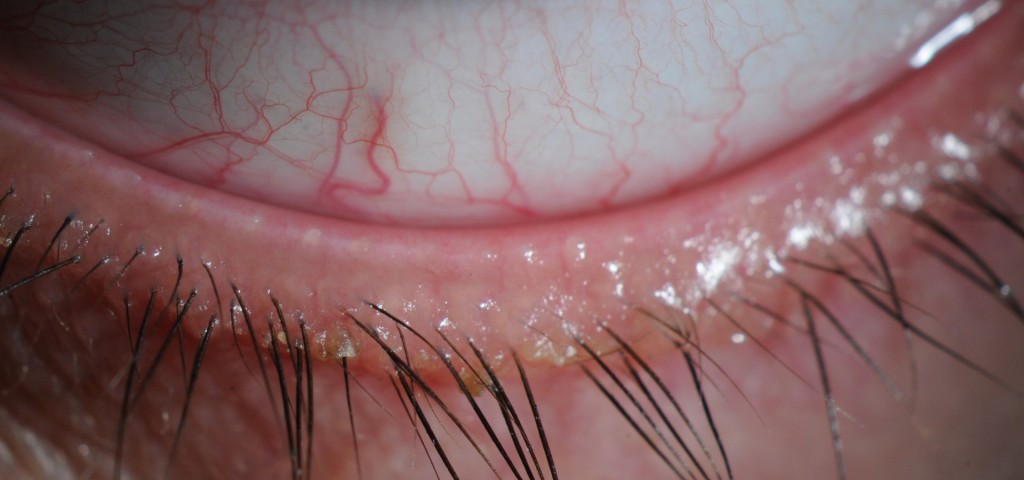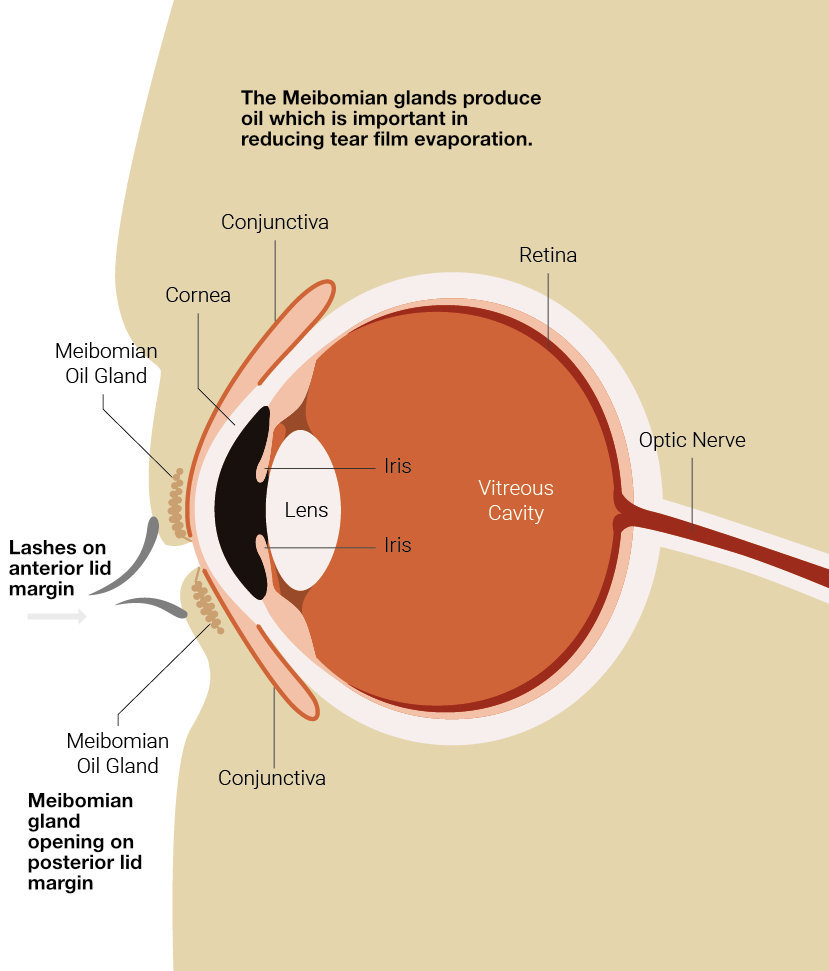Blepharitis
What is Blepharitis?
Blepharitis means inflammation (redness and swelling) of the eyelids. “Blepharos” is the Greek word for eyelid, and –“itis” means inflammation.
Blepharitis is very common. It accounts for about 1 in 20 eye problems reported to General Practitioners. It is not contagious. It is rarely sight threatening, but can be troublesome as it is a chronic, recurring condition. Symptoms may improve for several months then worsen again.
What are the symptoms of Blepharitis?
- Eyelids that stick together and are difficult to open, especially when you wake up
- Gritty, itchy sore eyelids in the morning
- Red eyes
- Dry eyes. Meibomian gland dysfunction causing blepharitis is the commonest cause of dry eye.
- More severe damage causes deformity of the eyelids, resulting in eyelashes growing inwards & loss of eyelashes
- Styes and Meibomian cysts (chalazion) are common if blepharitis is present.
Which parts of the eye are affected in Blepharitis?
There are 2 main types of Blepharitis, which can occur alone, or in combination:
Anterior Blepharitis – where the inflammation affects the skin around the base of the eyelashes
Posterior Blepharitis – where the inflammation affects the area behind the eyelashes, where the Meibomian oil glands open. Severe cases can damage the transparent lining over the white of the eye and inner eyelid (conjunctiva) and the clear window of the eye (the cornea).


What causes Blepharitis?
The commonest underlying problem in Blepharitis is dysfunction and blockage of the Meibomian oil glands in the eyelids.
Meibomian oil glands are like other sebaceous oily (pimple, acne) glands. Meibomian oil glands do not work well when we are stressed, or have not had enough sleep. Dysfunction of the Meibomian oil glands can be associated with a skin condition called rosacea. Seborrhoeic dermatitis is another skin condition associated with blepharitis.
When Meibomian oil glands are dysfunctional, rather than producing clear oil they become blocked and filled with a waxy whitish secretion. This causes 3 main eye problems:
1 There is no clear oil to keep the surface of the eyes moist and keep the vision smooth and clear, so dry eye occurs
2 The thickened waxy secretion acts like a gritty foreign body, causing irritation and itchiness
3 Bacteria including Staphylococcus can grow in the thickened secretions, adding to the discomfort. Anterior blepharitis has sometimes also been linked to Demodex mites.
Can blepharitis be cured?
It is not possible to cure blepharitis. However, symptoms can be alleviated by a number of mechanical and medical means. The aims of treatment are to:
A: Open up and express the blocked meibomian oil glands by using hot eyelid massage and oral antibiotics.
B: Keep the eyelids clean by removing crusts and treating any secondary infection and inflammation.
C: Replace tears.

How is Blepharitis Treated?
The following information is provided as a guide only. Careful assessment and treatment by an ophthalmologist or eye health professional who has the expert training and experience to accurately determine your diagnosis and best treatment approach is important.
Hot Eyelid Massage
The most important part of the treatment is HOT EYELID MASSAGE to melt and open up the waxy blockages of the glands and express healthy clear oil. Making hot eyelid massage part of your daily hygiene routine just after your shower (eg like brushing teeth) is the key to long term control of blepharitis. Success in the treatment of blepharitis requires a program that matches the treatment to your symptoms. Hot eyelid massage will form the mainstay of your treatment. It often takes 6 – 12 weeks before treatment starts to be effective.
The simplest (and often the best) way to correct Meibomian oil gland dysfunction is to hold a small thin folded hot towel or flannel over your eyelids to melt the thickened waxy oil in the Meibomian oil glands, and gently push backwards on your eyelids through the towel, near where the eyelashes come out, to express the natural oil from the gland openings near the eyelashes. Make the towel hot with running tap water which is quite hot (but not so hot that you can’t tolerate it). After counting for 10 seconds whilst pushing backwards towards the upper eyelashes, make the towel hot again, then put the hot towel over the lower eyelids on both sides and count for 10 seconds whilst pushing backwards near where the lower eyelashes come out. You can repeat this for another cycle, making it 10 seconds x 2 on the top eyelid and 10 seconds x 2 on the bottom eyelid.
This should not take up more than 40 seconds of your day. Make it part of your daily hygiene routine, either in the morning after coming out of the shower, or in the evening after brushing your teeth.
The main purpose of using hot running tap water, and re-heating the towel every 10 seconds, is to maintain a relatively constant and hot temperature of the hot towel. Avoid letting tap water get into your eyes. Do not wear contact lenses when carrying out hot eyelid massage. Contact lenses must never be worn in the shower or when swimming. The best towels to use are small, thin baby face towels. It is best to do the hot towel massage out of the shower, so that the water can be hot enough.
It is not recommended to roll a cotton bud downwards or upwards on the eyelid as this stretches the delicate thin eyelid skin and can lead to bags around the eyes.
When carried out correctly, hot eyelid massage helps restore Meibomian oil gland function, to express natural oily tears onto the surface of the eye. Expressing natural oily tears onto the surface of your eyes can mean that you don’t have to put in as many artificial tear drops.
If you see a small lump (chalazion) or whitish head on the eyelid margin, do the hot compress treatment frequently and massage locally at the location of the lump or white head, to try to open up the gland and encourage the lump to go away.
If the skin on your eyelids is dry or affected by eczema, the hot towel can make the skin feel more dry and irritated. If this is the case, eye masks which are heated in the microwave are available, or other masks containing hot beads. It is important to try to maintain a constant hot temperature (but not burn the skin on the eyelids), and to gently massage by pushing backwards on your eyelids, to express the oil from the Meibomian oil glands.
Mascara and eyeliner can block the openings of the Meibomian oil glands. It is best to remove mascara and eyeliner with a good quality, plain make up remover each night, and carry out hot eyelid massage to open up the glands. Try to have at least 1 or 2 make-up free days per week.
In some cases where it has not been possible to open the Meibomian oil glands with hot towel massage or other methods, gland expression treatments are available e.g. Lipiflow, MiBoFlo. Following these treatments, it is often necessary to maintain the improvement by daily hot towel massage.
Eyelash Cleaning
If you have anterior blepharitis with crusts and debris on the lashes, the hot eyelid massage must be followed by EYELASH CLEANING, which will also reduce the numbers of bacteria.
Use a fresh cotton bud moistened with cooled boiled water (or any sterile solution such as saline for contact lens users) to scrub the base of the lashes, removing crusts, debris and bacteria.
To remove crusts, it is often most practical to use proprietary cleaning pads or solutions on a cotton bud (eg Blephaclean, Blephasol or Supranettes). DO NOT CLEAN THE INSIDE (PINK) SURFACE of the eyelid. Some recommend using dilute bicarbonate of soda (One quarter teaspoon of sodium bicarbonate in one cup of cooled, boiled water, keeps in the fridge for 1 week). AVOID using baby shampoo as this removes the natural oils from the tear surface.
After at least 4 weeks of carrying out hot towel eyelid massage correctly, so that the Meibomian oil glands are producing smooth clear oil, and not waxy thick material, there should be much less anterior blepharitis collecting on the lashes, such that long term the need to clean the eyelashes will be reduced or eventually eliminated.
Eye Drops
Eye drops may be given to restore the tear film (lubricants usually used 1-6x daily as required), or to soothe inflammation (steroids or ciclosporin used as directed usually from 1-4x daily). Occasionally a course of antibiotic drops may be given. If you are taking steroids you must have the regular eye pressure check that has been recommended. Do not obtain steroid drops on repeat prescription as you may forget the check. Apply eye drops before ointment.
Ointment
OINTMENT may be given as a lubricant into the eye at bedtime. Alternatively, ointment applied to the lash line with a cotton bud or clean finger after lid cleaning may be given to reduce the level of bacteria (antibiotic) or, occasionally, to reduce the inflammation on the lid margin (steroid).
Oral Antibiotics
ORAL ANTIBIOTICS such as Doxycycline and Lymecycline are given principally for their anti-inflammatory properties and for the beneficial effect on the Meibomian secretions. Usually they are used at a low dose (50-100mg/day) for at least 6 to 12 weeks because the onset of action is slow. You do NOT have an infection that can be transmitted.
These antibiotics are used in a similar way that dermatologists treat acne. The oral antibiotics will also clear up facial acne. The antibiotics must not be taken by women intending to fall pregnant. They should be taken in the morning with food, milk or probiotic yoghurt, and must never be taken at bedtime. Oral Azithromycin is an alternative which has been reported to be effective in Meibomian gland dysfunction.
Alternative Therapies
Increased omega-3-fish oil intake (regularly eating oily fish such as salmon, sardines or taken as omega 3 fish oil supplements- not cod liver oil) also helps to reduce eyelid inflammation, and flax-seed oilsupplements make Meibomian secretions less thick and improve the tear film (Macsai M, Trans Am Ophth Soc 2008).
Is there anything can I do to prevent blepharitis flaring up?
A skin condition called ROSACEA is often associated with blepharitis. This causes a flushed rosy complexion and dysfunctional oil glands in the skin. Avoiding factors which cause facial flushing and worsening the oil gland dysfunction, including avoiding alcohol and curries/ chilli can significantly help both blepharitis and rosacea. Avoiding or minimising stress and getting enough sleep can also significantly help.
- Be diligent about hot eyelid massage every day, as part of your hygiene routine
- Stop smoking
- Eat oily fish and/or omega 3 fish oil supplements
- Get enough sleep and minimise stress.
- Temporarily avoid alcohol and chilli/curry during periods when the blepharitis is active.
Don't take our word for it
Reviews from happy patients
Message Us
Get In touch below. Ask Any Questions or Start a Free Quote
Call Us
0203 328 0076
This site is protected by reCAPTCHA and the Google Privacy Policy and Terms of Service apply.
Clinic Address
The London Clinic 119 Harley Street London W1G 6AU
Open Hours
pm@valeriesaw.com